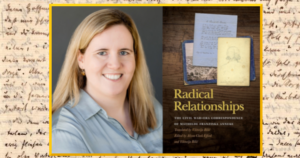She was a revolutionary who delivered lectures on feminism and worked with the likes of Susan B. Anthony and Elizabeth Cady Stanton. She founded a school for girls and advocated passionately for women’s education. She wrote for newspapers, traveled extensively, and began a passionate relationship with another woman– a Milwaukeean named Mary Booth.
Her name was Mathilde Anneke, and she’s at the heart of Viktorija Bilic’s latest research.
Bilic, an associate professor in UWM’s Translation and Interpreting Studies program, is the coeditor of the new book, “Radical Relationships: The Civil War Era Correspondence of Mathilde Franziska Anneke.” She and coeditor Alison Clark Efford, a historian at Marquette University, debuted their work on Sept. 1. The book is a collection of Anneke’s letters, translated from their original 19th century German to reveal a glimpse into the life of a woman that history has mostly passed over.
“Very few people know about (Anneke),” Bilic lamented. “She’s not as well-known as she should be.”
A revolutionary radical
When Bilic says Anneke was a radical, she means it. Anneke fought right alongside the men during the failed 1848 revolution in Germany. Defeated, Anneke and other “1848ers” fled their native land and settled in Milwaukee.
“Milwaukee was called ‘German Athens,’ because so many immigrants moved there,” Bilic said. “In 1910, half of the city’s population claimed German ancestry. In the late 19th century, people would walk into a store and vendors felt like they had to put up signs: ‘English Spoken Here,’ because of course, German was spoken there.”
There were other famous names in the wave of ‘48ers, including Peter Engelmann, for whom UWM’s Engelmann Hall is named, and Karl Schurz, whose wife, Margarethe Meyer Schurz, founded the first private kindergarten in Wisconsin.
In Milwaukee, Anneke met Mary Booth, and a relationship blossomed between the two women. As Anneke’s husband Fritz fought for the Union during the Civil War, she and Booth traveled to Zurich and lived together until Booth’s death in 1865. Anneke later returned to Milwaukee, where she spent the rest of her life advocating for women’s education and suffrage.
Unfortunately, Bilic said, there is so much about Anneke’s life that had to be left out of the book. For length, they focused on the letters Anneke wrote during the Civil War. “The letters are very emotional and also tell about her relationships – radical relationships with Mary Booth, her partner; with Fritz, her husband; and other radical women she met and associated with when she was in Zurich,” said Bilic.
A friend or lover?
For historians, the great mystery surrounding Anneke’s life was the nature of her relationship with Mary Booth. They were domestic partners, but were they lovers? Bilic doesn’t know.
“I’ve seen sources where people made her to be a queer pioneer or something. She wasn’t that,” Bilic said firmly. “We (Bilic and Efford) believe that Mary Booth was the love of her life, in a way, because Mathilde says so in her letters. She also tells Fritz, ‘We should have stayed friends. … We’re not connected like lovers anymore.’ Her letters to Mary and Mary’s to her were very affectionate, but we never know whether it actually became physical. They shared a bed, yes, but that was also not uncommon in the day.”
In the end, Bilic said, she translated the letters between Anneke and Booth to the best of their ability and left the audience to decide the nature of their relationship.
The trials of translation
To give the audience the best information possible, Bilic, who specializes in historical translation, spent five years deciphering Anneke’s thousands of letters. But historical translation isn’t as simple as glancing at the German and writing the English equivalent. To start with, you have to learn ‘Kurrentschrift,’ the script in which most Germans wrote up until around 1911.
“If you don’t work with historical documents now, you can’t read it. It’s something that I have done for such a long time that I can read it like any other script, but it took me awhile,” Bilic said. “That’s the first step, is transcribing it. I was transcribing those letters for maybe two years.”
After the letters were in a more readable format, Bilic still had to convert the text from German to English. But this wasn’t any German – it was 19th century German, full of phrases and idioms that don’t translate well, if at all. On top of that, Anneke constantly discussed the people around her in her letters. Fritz or Mary might have known who she was talking about, but it was a mystery to Bilic and Efford.
“(She mentions) like, ten different Karls. Was it Karl her brother-in-law; Carl Lachmund, a Hanover-born second lieutenant in Fritz Anneke’s regiment; or another Karl? Sometimes you can tell from context, but for that, you have to know everything you possibly can about your letter writers,” Bilic said.
So, she and Efford researched both the language of the time and Anneke’s connections. Bilic visited Germany and Switzerland to examine historical documents revealing more of Anneke’s life. Efford’s knowledge of German immigrant history proved invaluable.
“It makes for a better book that I collaborated with a historian who could provide the historical background in a way that I couldn’t have done, and she couldn’t have translated the letters the way that I did,” Bilic said.
And that faithful translation is important, she added.
“I feel, as a translator, you have a responsibility to do right by those people,” she said. “(You must) give them a voice.”
Bilic’s book is available through the University of Georgia Press .
By Sarah Vickery, College of Letters & Science
